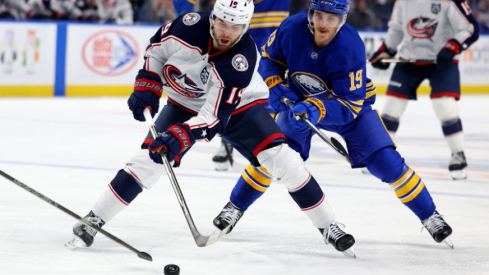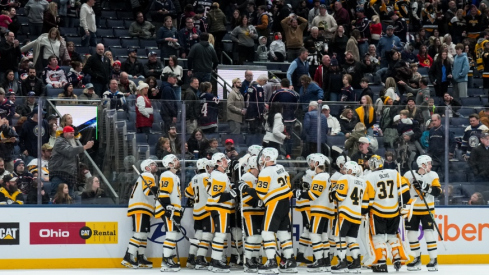When Alexander Wennberg was drafted by the Columbus Blue Jackets with the 14th overall pick in 2013, he was expected to take on a big role with the team. After doubling his rookie point total from 20 to 40, he took a giant leap forward this past season, tallying 59 points, which saw him tie for 15th in the NHL in assists with 46 in 80 games.
Now that his entry-level contract has expired, he's a restricted free agent (RFA), meaning that Columbus still owns his contract rights but must sign him this offseason.
Coming out of an entry-level contract can be a tricky negotiation for both player and management to navigate (remember Ryan Johansen?). The player and his representation may push for a long-term contract, but this could lower a player's average annual salary (AAV), effectively betting against himself.
Similarly, teams are often reluctant to hand out longer contracts to players who are still finding their way in the NHL. On the other hand, some agents and teams prefer a two or three-year "bridge contract", allowing the player to still have RFA rights after the contract expires, but also entitling the potential for a larger payday coming out of that second contract (thus bridging the gap between an entry-level contract and a big ticket). In recent years, these bridge deals have become much more common, especially for players of Wennberg's ilk.
Fortunately, in a salary cap world, it's become much easier to project player salaries based on a number of variables, including age, production, and position. Which players, then, are considered to have similar profiles to Alexander Wennberg?
Mark Stone
The 25-year old Ottawa Senators winger has had an impressive start to his career, posting 187 points in 249 games (0.75 points per game), including 72 in 103 (0.70 PPG) before his entry-level contract ended. In the summer of 2015 he signed a 3 year, $10.5M contract. Per capfriendly, the $3.5M AAV put his cap hit at 4.9% of the team's salary cap in the year in which he signed the contract. More sniper than playmaker, Stone is tempting fate with a career 15.6% shooting percentage, obliterating the league average. Still, he has has three consecutive years with 20+ goals and 30+ assists, and is heading into the last year on his current contract.
Mikael Granlund
This Finnish-born Minnesota Wild forward is a solid, dependable two-way player who was drafted in the first round, ninth overall, in 2010. By the end of his entry-level deal, Granlund had produced 88 points in 158 games (0.56 PPG), and took a nice step forward in 2016-17, similar to Wennberg, by posting 69 points (26 goals and 43 assists). In the summer of 2015, he signed his post-entry level contract, a two-year, $6M deal ($3M AAV) that accounted for 4.11% of the team's salary cap when he signed. It is worth mentioning that, despite the fact that Granlund played mostly center for his first four years in the NHL, he moved to the wing for most of last year, the year in which he put up his best offensive numbers. The 25-year-old is currently an RFA and should expect a raise in his own right.
Through each of their entry-level contracts, take a look at these three players' stats. What jumps out is Wennberg's games played, but also how closely his stats align with entry-level Granlund. Also, it's tough to ignore Stone's scoring prowess, and how he has more goals than Wennberg despite playing in less than half the amount of games.
| GP | G | A | PTS | PTS/GM | +/- | PIM | ATOI | SH% | |
|---|---|---|---|---|---|---|---|---|---|
| ALEXANDER WENNBERG | 217 | 25 | 94 | 119 | .55 | -11 | 45 | 16:43 | 8.6 |
| MIKAEL GRANLUND | 158 | 18 | 70 | 88 | .56 | 10 | 48 | 16:52 | 7.5 |
| MARK STONE | 103 | 30 | 42 | 72 | .70 | 25 | 20 | 16:17 | 15.3 |
If Wennberg were to sign a bridge contract comparable to Stone or Granlund, it should bode well for the Blue Jackets. Wennberg, soon to be 23 years old as of this writing, will head into the season as the team's top center, but based on player comparisons, shouldn't come close to breaking the bank. Wennberg could very well sign a bridge deal given that he's essentially doubled his point production in each of his three years in the league, and he has shown that he possesses top-end playmaking ability. He could be leaving millions of dollars on the table by signing a long-term contract and betting against his continued upward projection.
#CBJ Tortorella said the plan is to put Panarin on a line with C Alexander Wennberg and "let him go." Not sure yet who's at right wing.
— Aaron Portzline (@Aportzline) June 23, 2017
Despite the fact that Wennberg had a breakout campaign, he was noticeably a less effective player in the second half of the season and into the playoffs. In his last 40 regular season games, he had just five goals and saw his PDO (a combination of shooting percentage and on-ice save percentage) normalize. In the playoffs, he had just one point in five games and his performance was further accentuated by the brilliant play of Sidney Crosby and Evgeni Malkin, the Penguins' top two centermen.
With nearly $13M in projected cap space, the Blue Jackets have plenty of flexibility to sign Wennberg (as well as fellow RFA Josh Anderson) to a short or longer-term contract. One would expect that, based on player comparison analysis, Wennberg will be in the neighborhood of 2-3 years with an AAV of $3-$4M, which sounds a lot like grand larceny for a playoff team's top line center. With a $75M salary cap in 2017-18, even 5% of the cap still only amounts to $3.75M.
Official guess: 2 years, $3.5M AAV.


